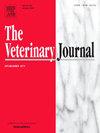Evaluation of circulating microRNAs in plasma from horses with non-strangulating intestinal infarction and idiopathic peritonitis
IF 3.1
2区 农林科学
Q1 VETERINARY SCIENCES
引用次数: 0
Abstract
Non-strangulating intestinal infarctions (NSII) associated with Strongylus vulgaris infection and idiopathic peritonitis (IP) share similar clinical presentation but require different treatment approaches. Horses with NSII need surgical intervention, while idiopathic peritonitis cases can be successfully treated with antimicrobials. A correct diagnosis is thus crucial, but because the two diseases overlap in clinicopathological features, differentiation is difficult in clinical practice. MicroRNAs (miRNAs) are non-coding RNAs that exhibit measurable changes in abundance in tissues and circulation during disease. This study aimed to explore differences in plasma miRNA abundance between patients with NSII and IP. Plasma samples were collected from 43 horses, consisting of 21 with NSII and 22 with IP. A subset (n = 12) was submitted for deep small RNA sequencing to identify miRNAs differing between the groups. Next, a panel of nine miRNAs (two were potential normalizers) were selected for evaluation and confirmation by reverse transcription quantitative real-time PCR (RT-qPCR). Small RNA sequencing detected 628 miRNAs in the blood samples, but no miRNAs were differentially abundant between the disease groups. This finding was confirmed by qPCR. In agreement with previous studies, the top abundant miRNAs in both groups included Eca-Mir-122–5p and Eca-Mir-486–5p, as well as Eca-Mir-223–3p, which has previously been associated with inflammation. Target prediction for the most abundant miRNAs additionally predicted targets in inflammatory pathways. Evaluation of clinicopathological parameters revealed differences between the groups in two measures (white blood cell count and blood neutrophil count), which aligns with findings from previous studies. The results demonstrate that NSII and IP elicit similar miRNA profiles in plasma and are characterized by systemic inflammation.
非绞窄性肠梗死和特发性腹膜炎马血浆循环microrna的评价。
非绞窄性肠梗死(NSII)与寻常圆形线虫感染和特发性腹膜炎(IP)有相似的临床表现,但需要不同的治疗方法。患有NSII的马需要手术干预,而特发性腹膜炎病例可以用抗菌剂成功治疗。因此,正确的诊断是至关重要的,但由于两种疾病在临床病理特征上重叠,在临床实践中很难区分。MicroRNAs (miRNAs)是非编码rna,在疾病期间在组织和循环中表现出可测量的丰度变化。本研究旨在探讨NSII和IP患者血浆miRNA丰度的差异。收集了43匹马的血浆样本,其中21匹患有NSII, 22匹患有IP。一个子集(n=12)被提交进行深度小RNA测序,以鉴定组间不同的mirna。接下来,选择9个mirna(其中2个是潜在的正常化因子),通过逆转录定量实时PCR (RT-qPCR)进行评估和确认。小RNA测序在血液样本中检测到628种mirna,但在疾病组之间没有差异丰富的mirna。qPCR证实了这一发现。与之前的研究一致,两组中含量最高的mirna包括Eca-Mir-122-5p和Eca-Mir-486-5p,以及之前与炎症相关的Eca-Mir-223-3p。对最丰富的mirna的靶标预测还可以预测炎症通路中的靶标。临床病理参数的评估揭示了两组之间的差异(白细胞计数和血液中性粒细胞计数),这与先前的研究结果一致。结果表明,NSII和IP在血浆中引发相似的miRNA谱,并以全身性炎症为特征。
本文章由计算机程序翻译,如有差异,请以英文原文为准。
求助全文
约1分钟内获得全文
求助全文
来源期刊

Veterinary journal
农林科学-兽医学
CiteScore
4.10
自引率
4.50%
发文量
79
审稿时长
40 days
期刊介绍:
The Veterinary Journal (established 1875) publishes worldwide contributions on all aspects of veterinary science and its related subjects. It provides regular book reviews and a short communications section. The journal regularly commissions topical reviews and commentaries on features of major importance. Research areas include infectious diseases, applied biochemistry, parasitology, endocrinology, microbiology, immunology, pathology, pharmacology, physiology, molecular biology, immunogenetics, surgery, ophthalmology, dermatology and oncology.
 求助内容:
求助内容: 应助结果提醒方式:
应助结果提醒方式:


